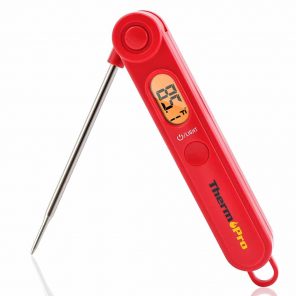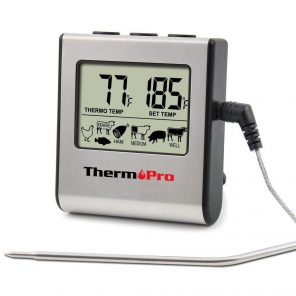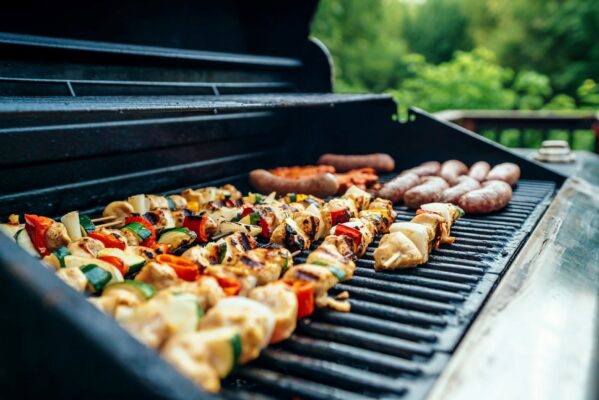The customer service team is always listening, taking notes, and quantifying complaints to ensure our products are continually improved. Due to selling directly to you, the customer, via Amazon, we can use product reviews to help us improve our existing products or help further development of new products.
Table of Contents
Have you ever gone to a barbecue, and the best piece of meat was a fat brisket covered in a dark coating of delicious goodness? That’s black bark BBQ.
If you’ve ever tried to get that thick layer of bark on your own smoked meats, you probably know how difficult it can be. You have to have the perfect cooking conditions to make it properly, and we’re here to help you perfect the process.
What Is BBQ Bark?
Whether it’s black bark BBQ or light bark BBQ, the bark is always made in the same way, and both types are the same thing. Bark is just the thick and chewy layer of dark crust on the surface of smoked meats.
You shouldn’t confuse true bark BBQ with charred meat, though. The formation of bark might make your meat look burnt, but it has nothing in common with improperly cooked barbecue.
Bark should be flavorful, textured well, and an enhancement to the natural flavor of the meat.
It relies on the Maillard reaction to form properly, and all of your cooking conditions have to be perfect to make it.
As the fat renders out of the meat, it forms a thin layer of liquid fat on the surface. Smoke adds flavor to that thin layer of fat, and the spices you rubbed it with slowly infuse with the fat.
The mixture congeals, and it concentrates all of those flavors into mouth watering bark. For that to happen, your meat has to have the proper amount of fat and the right mixture of spices. Temperature also plays a big part in bark formation.
We know that BBQ bark is tasty, but is the bark on BBQ healthy, though? Well, it’s not the worst thing in the world, but it isn’t going to be added to any up and coming health fads.
Bark is made almost entirely out of fat, salt, and spices. So, it has a high amount of sodium and saturated fat. It’s also found on smoked meat, and some studies show that smoking meat produces small amounts of carcinogens.
Luckily, the average person doesn’t eat barbecue frequently enough to experience any negative side effects from the carcinogens, and fat and sodium are perfectly fine in reasonable amounts. Just don’t eat it everyday.
How To Get A Good BBQ Bark Like A Pro?
Now that you know what BBQ bark is, you probably want to hear how you can form your own delicious bark the next time you smoke some tender ribs or juicy brisket.
If you want to start forming beautiful crusts of bark, you’ll need the following items:
- Smoker
- Food thermometer
- Your favorite dry rub
- Meat to smoke
The Smoker
Before we get started on this, it’s important to know that you can do the same thing with a standard charcoal grill. You don’t need a complicated smoking setup to make great barbecue bark. Just make sure you keep the temperature low. Don’t keep it too low, though. If you don’t reach a high enough temperature, you won’t get any bark on your meat, and you might even slice open an uncooked and tough piece of meat on accident.
For the purposes of making the highest quality bark layer on your meats, you’ll want to keep your smoker at around 225 degrees. If it doesn’t work perfectly the first time, try to adjust the temperature a little higher, but don’t exceed 300 degrees. Every cook knows that different grills and smokers behave differently, and you might have to experiment a little to find your grill’s sweet spot.
Most smokers have a water pan that you can fill with water, but if you’re using a grill, you’ll want to add your own makeshift water pan to produce water vapor. It’ll really help generate moist smoke.
The Food Thermometer
A good food thermometer is essential to making perfectly smoked meats. You’ll have to gauge and monitor your meat’s temperature frequently, and a cheap thermometer just won’t cut it.
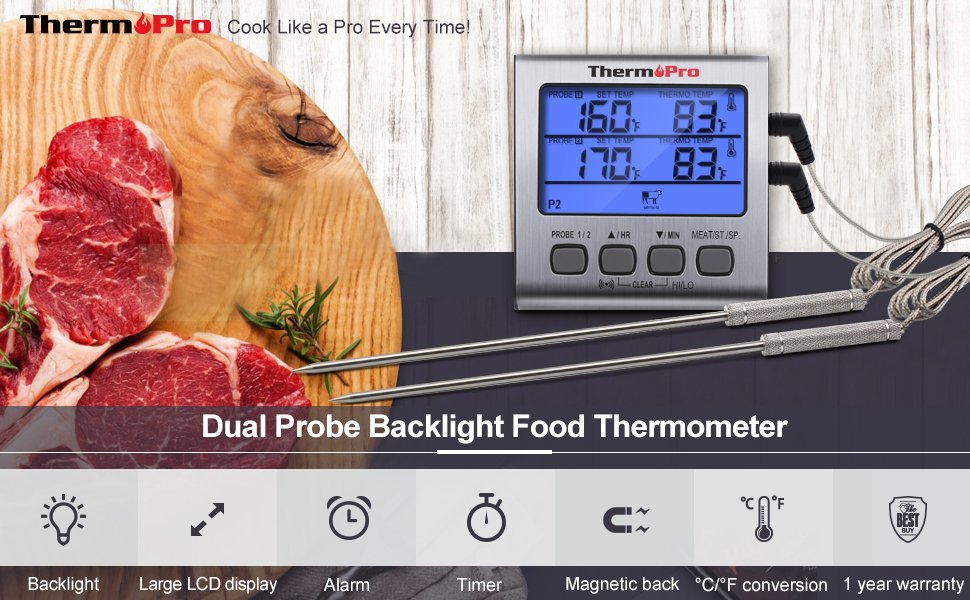
We recommend something around the same quality as a ThermoPro food thermometer to ensure that you get great results every time.
-
ThermoPro TP-16 Large LCD Digital Food Meat Thermometer
$19.99 $19.99Rated 4.89 out of 5Add to cart
The Rub
That vast majority of popular dry rub recipes are perfectly fine for creating bark, but you still want to make sure your rub mixture has plenty of salt and sugar. Those are the two main seasonings that help form a layer of bark.
If you’re new to barbecuing meats, you can try this mixture:
- Salt
- Brown sugar
- Paprika
- Garlic powder
That’s a no-frills recipe, but it’s a good way for beginners to learn how to make dry rubs. As you get more experienced with smoking meats, you’ll be able to add or remove ingredients to find the flavor profile you really want.
If you’re just starting out, a lot of seasoned pit masters will suggest that you add your sugar within the last couple hours of smoking. That’s fairly solid advice. When sugar is exposed to high temperatures, it burns and becomes bitter. Smoking is generally done at very low temperatures, but beginners can still accidentally char an entire brisket by adding the sugar at the start.
The Meat
The meat you choose to barbecue plays a pivotal role in whether or not you’ll produce a good layer of bark. You can smoke just about anything, but you’ll want to stick to a few specific cuts of meat for good bark layers.
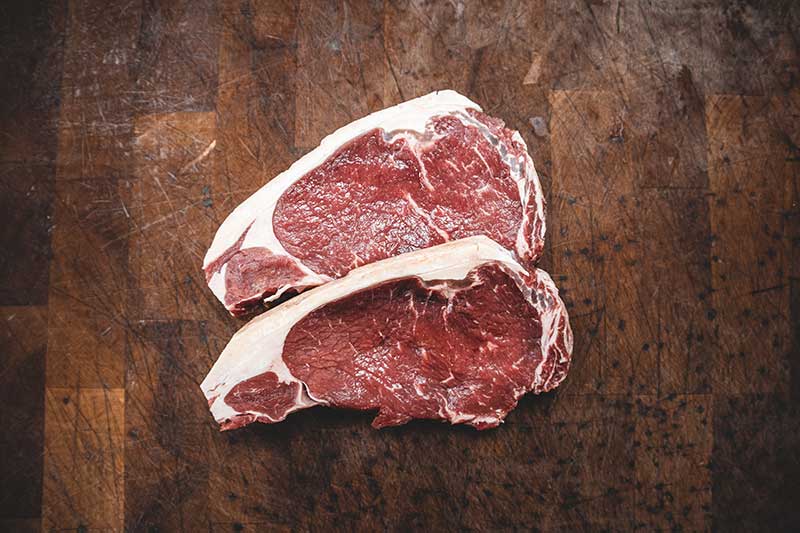
- Brisket
- Beef ribs
- Pork ribs
- Pork shoulder
Those cuts of meat have more than enough fat to stay juicy throughout long smoking sessions, and they can develop beautiful layers of bark. You can use others, but you’ll have to experiment to see what works outside of our suggestions.
If you get a particularly fatty piece like brisket, you’ll want to trim a little bit of fat off. Don’t remove all of the fat. You just want to cut off larger chunks of it. While fat is necessary for bark development, excessive amounts of fat will prevent bark from forming.
Common Reasons For Little Or No Bark
Have you kept your temperature set perfectly, applied the right rub mixture, and used a good cut of meat, and you still couldn’t get a good bark on your barbecue? It’s a pretty common problem, and here are some of the reasons for that.
Too Much Fat
Fat is crucial to the chemical reaction that causes bark to form, but too much of it will keep you from getting a good layer of bark.
All of the cuts we suggested are naturally very fatty cuts of meat, and they often need to be trimmed to balance their fat content out. To trim your meat, you just need to remove the thick chunks of fat in certain sections. Don’t remove them entirely. Just thin them out a bit.
The best example of a meat that needs this is brisket. If you look at the top of a brisket, it has a very thick layer of fat across the top most of the time. Sometimes butchers trim it down for you, but you’ll usually have to do it yourself. Don’t try to filet the fat off, or you won’t have enough fat to make bark. Just take slivers of it off until it’s a thinner layer.
Not Enough Time
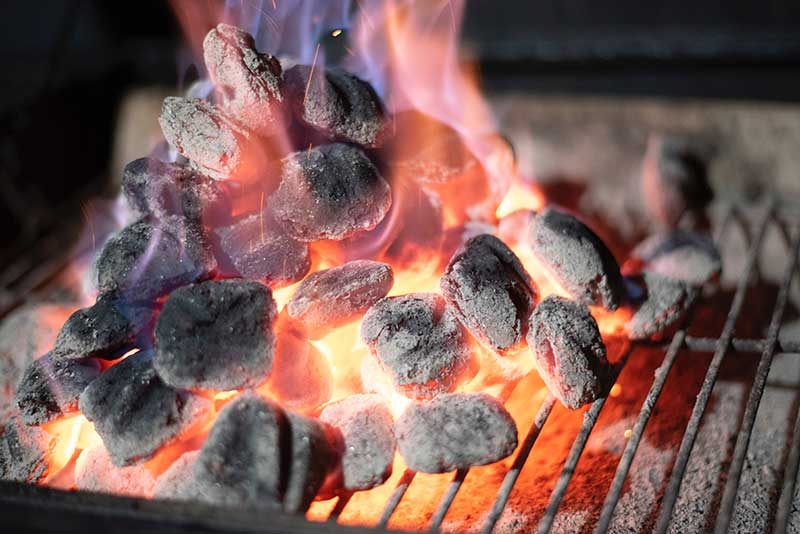
Creating bark is a time consuming process. You have to hold the meat at a low cooking temperature, and you have to cook it for a long time. Bigger cuts of meat can take twelve or more hours sometimes. If you’re only smoking your meat for a few hours, you won’t get any delicious bark. Not to mention, it’ll probably be raw in the middle due to the low temperatures used.
Not Enough Heat
While smoking food requires low temperatures, there is a limit. Bark is formed by the Maillard reaction, and you have to have a temperature of 235 to 250 degrees to cause the reaction to happen.
If you’re trying to cook your meat at a lower temperature, it might become an awesome piece of meat after enough time has passed, but it won’t develop any bark.
Rub Quality
You need fat, salt, and sugar on the surface of your meat to get a good layer of bark. A lot of people get the fat and salt right, but they usually mess up the sugar.
If you don’t have enough sugar in your rub, you’ll get a thin layer of bark that doesn’t really enhance the meat. Depending on the cut of meat and the rest of the spices in your rub, you’ll want to experiment with the amount of sugar you add.
If your meat is becoming charred, it’s because your sugar is getting too hot. You can counteract this in a couple of ways.
First, you can try cooking at a lower temperature. That should prevent the sugar from burning, and it should slowly turn into bark.
Second, you can put the sugar on your meat later in the cooking process. If there’s no sugar present, you can let the bark start to develop, and then add the sugar a few hours before the end of the cooking session. That’ll give the bark the sugar it needs to form properly towards the end, and it will prevent the surface of your meat from charring.
Conclusion
Creating a great bark on your barbecue may sound complicated, but it’s not that difficult. Once you do it properly the first time, it’ll be as easy as riding a bicycle. The key to making bark that first time is experimentation and balancing out your different components properly.
If this is your first time trying to make a bark-covered meat, we suggest using a brisket, and you should add the sugar towards the end. That’s the easiest meat to form bark on, and you have a little bit of wiggle room to mess up with it.

